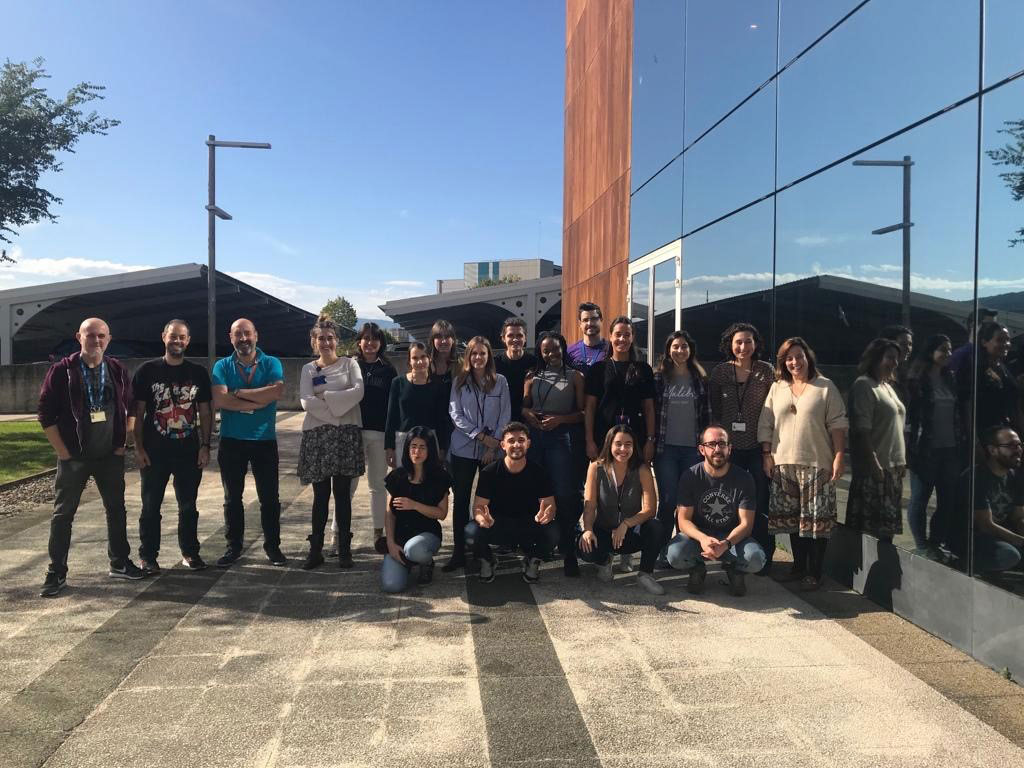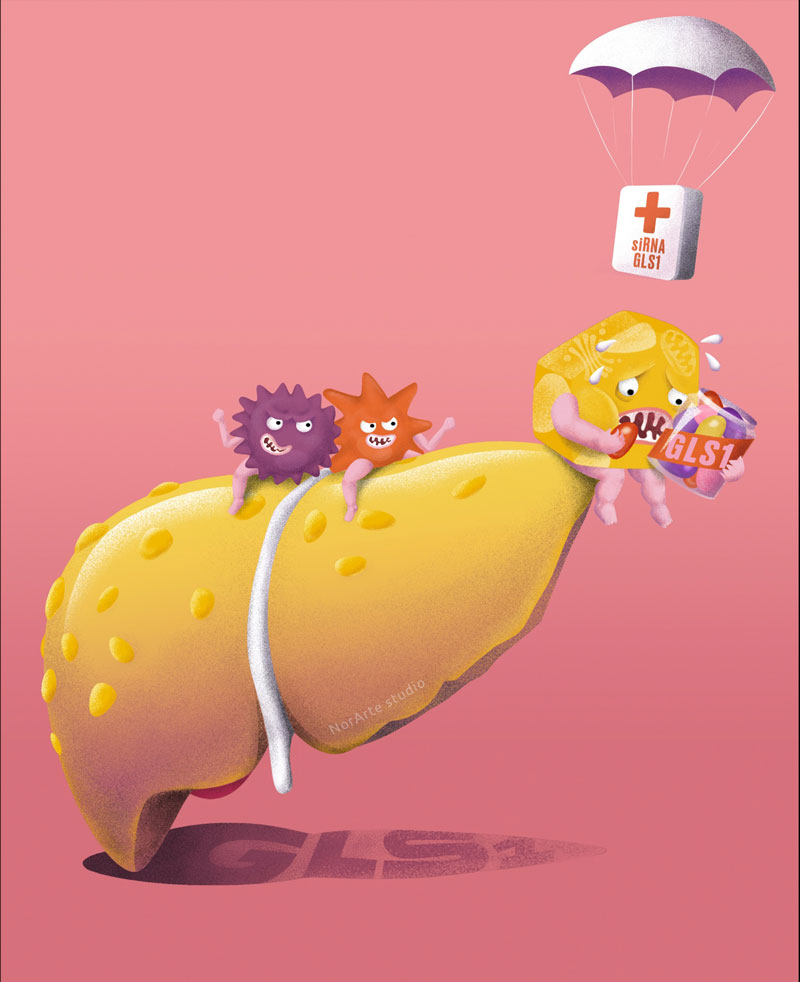
2020/03/03
Research by CIC bioGUNE proposes enzyme silencing as a new therapeutic approach for the treatment of non-alcoholic fatty liver disease
The study, published in the journal Cell Metabolism, reveals that hepatic glutaminase (GLS1) is augmented in non-alcoholic fatty liver disease.
Led by Drs. Teresa Cardoso Delgado and Malu Martínez-Chantar, the research shows that, during non-alcoholic fatty liver disease, the hepatic catabolism of the amino acid glutamine is altered.
(Bilbao, 3 March 2020). A study led by Drs. Teresa Cardoso Delgado and Malu Martínez Chantar, both researchers at CIC bioGUNE - a member of the Basque Research & Technology Alliance, BRTA -, has shown that levels of the hepatic enzyme glutaminase 1 (GLS1) are increased in non-alcoholic fatty liver disease. Its silencing therefore represents a potential therapeutic approach for the treatment of this disease.
The research, published in the journal Cell Metabolism, shows that, in the course of non-alcoholic fatty liver disease, a metabolic reprogramming takes place whereby the hepatic catabolism of the amino acid glutamine is altered. Under these conditions, the hepatic enzyme glutaminase 1 (GLS1) is increased, triggering glutamine usage to fuel the energy demand of the cell.
“It is important to emphasize that the accumulation of fat and inflammation in the liver has been reduced without adverse effects by silencing this liver enzyme, using pre-clinical animal models of diet-induced non-alcoholic steatohepatitis,” Dr. Malu Martínez-Chantar explains.
In this study by Jorge Simon et al.,the mechanism underlying the beneficial effect of silencing GLS1 in the liver has been explore in depth. In short, the silencing of the liver enzyme glutaminase 1 (GLS1) is proposed as a new therapeutic approach for the treatment of non-alcoholic fatty liver disease.
This disease is a very common disorder comprising a group of conditions that share the common feature of accumulation of fat in the liver. The disease ranges from simple steatosis to non-alcoholic steatohepatitis (NASH), characterized by inflammation and liver fibrosis, and may progress to advanced fibrosis and cirrhosis.
Over a billion people affected worldwide
Obesity is a pandemic and a risk factor for non-alcoholic fatty liver disease. The global prevalence of this disease is estimated to stand at around 25%, with more than a billion people affected worldwide. Patients with non-alcoholic fatty liver disease are at increased risk of liver-related morbidity and mortality, as well as metabolic co-morbidities, such as liver cancer, the second most deadly cancer, and cardiovascular disease, the leading cause of death worldwide.
Despite the alarming figures associated with the pathology of non-alcoholic fatty liver disease, and the large number of emerging therapies currently being evaluated in clinical trials, there is still no approved drug therapy for the clinical treatment of non-alcoholic fatty liver disease.
This work is the result of an interdisciplinary collaboration led by Dr. Malu Martínez-Chantar, who heads the CIC bioGUNE Liver Disease Laboratory and a group belonging to the Research Centre Network for Liver and Digestive Disorders (CIBEREHD). A number of other research groups have also collaborated in this project, namely the Metabolomics Platform at CIC bioGUNE (CIBEREHD), the Precision Medicine and Metabolism Laboratory at CIC bioGUNE (CIBEREHD), the Physiology Department of the Faculty of Medicine and Nursing (University of the Basque Country), the biotechnology company OWL Metabolomics and the Department of Physiology at the University of Santiago de Compostela, CIMUS (CIBEROBN).
In addition, the work has also benefitted from international collaboration with the Department of Gastroenterology at the University of Modena (Italy) and the Division of Digestive and Liver Diseases, Department of Medicine, Cedars-Sinai Medical Center (Los Angeles, USA), alongside that of Spanish hospitals such as the Unit for the Clinical Management of Digestive Diseases at the Virgen del Rocío University Hospital and the Department of Gastroenterology and Hepatology at the Marqués de Valdecilla University Hospital, both members of CIBEREHD.
The financial support provided mostly by the Spanish Ministry of Science and Innovation, the BBVA Foundation, the Spanish Cancer Association (AECC) and all those who participated in the Crowdfunding Campaign #Bermeotunacontraelc Cáncer organised by the AECC Bizkaia, has been essential to conduct the research. Likewise, the support given by patients with non-alcoholic fatty liver disease and health professionals who participated in this study has also played an important role.
About CIC bioGUNE
The Centre for Cooperative Research in Biosciences (CIC bioGUNE), located in the Bizkaia Technology Park, is a biomedical research organisation conducting cutting-edge research at the interface between structural, molecular and cell biology, with a particular focus on generating knowledge on the molecular bases of disease, for use in the development of new diagnostic methods and advanced therapies. CIC bioGUNE has been accredited as a “Severo Ochoa Centre of Excellence”, the highest level of recognition for centres of excellence in Spain.
About the BRTA
The BRTA is an alliance formed by 4 collaborative research centers (CIC bioGUNE, CIC nanoGUNE, CIC biomaGUNE and CIC energiGUNE) and 12 technology centers (Azterlan, Azti, Ceit, Cidetec, Gaiker, Ideko, Ikerlan, Lortek, Neiker, Tecnalia, Tekniker and Vicometch), with the aim of developing advanced technological solutions for Basque companies.
With the support of the Basque Government, the SPRI Group and the Provincial Councils of the three territories, the alliance seeks to promote collaboration among its centers; to strengthen the conditions to generate and transfer knowledge to companies, contributing to their competitiveness; and to spread Basque scientific and technological capacity.
BRTA has a staff of 3,500 professionals, executes 22% of Euskadi's R&D investment, generates an annual turnover of more than 300 million euros and files 100 European and international patents per year.
CIC bioGUNE, member of the Basque Research & Technology Alliance, BRTA
See a large version of the first picture

See a large version of the second picture





